Falcon Addiction
Air Date: Week of May 18, 2007
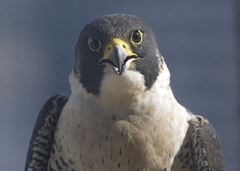
This front view of Gracie shows the protrusion on the upper mandible (tomial tooth) just behind the curve of the beak, and the matching depression in the lower mandible- two features that are used to aid in severing the spinal cord after prey has been caught. (Copyright © 2006/2007 Glenn Nevill)
Peregrine falcons are no longer endangered; in fact, they're thriving. They seem to prefer nesting in downtown cities, and in San Jose, California that's spawned a small movement of people who follow the birds' love lives and the antics of their fuzzy-headed hatchlings on webcams. Nancy Mullane reports.
Transcript
GELLERMAN: This week we have two reports on the frontiers of finding our fine-feathered friends. In a few minutes, I pod therefore I bird. But first, we head for the urban byways of the San Francisco bay area. That’s where a once-endangered bird is now making a comeback from the brink. In 1970, there were only two known nesting pairs of Peregrine falcons in all of California and none east of the Mississippi. Peregrines are known for their breathtaking dives, plunging to earth at over 200 miles an hour, but the pesticide DDT nearly decimated the falcons.
Thirty years on people have helped Peregrines make a remarkable recovery. And now many of the birds are nesting right in the middle of American cities. The drama of their recovery is due in part to the development of new urban habitats and technologies which are turning some city folk into the falcon obsessed. Nancy Mullane reports.
[CITY SOUNDS OF SAN JOSE CITY HALL]
LOEWEN: If you turn and look, this is the south side of the building, and at the top of it, you see this white box and that’s the nest box.
MULLANE: Evet Loewen is Chief Deputy City Attorney for San Jose. But instead of sitting in her office chair looking at briefs, she’s standing on the ground outside City Hall looking up. It wasn’t always like this. About eighteen months ago Jose and Clara, a pair of peregrine falcons set up housekeeping on a ledge on the side of the city hall building. Now, Loewen says, she’s not the only one transfixed by the raptors and their three new baby chicks.
LOEWEN: I have yet to run into a city department where people weren’t talking about the birds. They call me up and leave me messages on my phone. They talk to the city attorney and let him know and I know the mayor is very interested in the birds.
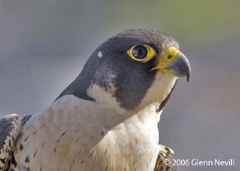
This photo of Gracie was shot on the day that the first egg was discovered. It shows a white feather behind her right eye that has been used to help identify her from a distance through spotting scopes. (Copyright © 2006/2007 Glenn Nevill)
LOEWEN: There’s a group of us that are very dedicated and will want to make sure those birds are safe. It’s something you know I think there will be many, many, many people out when they think those birds will take their first flight.

This first falcon egg of the season (photo taken through window) was found in planter on the 30th floor balcony of 201
Mission, San Francisco. Discovery of the egg in this unexpected location led to the closing of the balcony for security and a flurry of activity to get permission to move the web camera to the new site. (Copyright © 2006/2007 Glenn Nevill)
MULLANE: One way Loewen and the others track the fledglings daily developments, while they’re stuck at their desks, is through a 24-7 webcam. It was set up at the nest by the UC Santa Cruz Predatory Bird Research Group so people could watch the birds live, minute by minute. Sometimes demand overwhelms the system.
STAVELEY: It can crash, ah, it has crashed (laughs).
MULLANE: Claire Staveley manages the web-cam for the Research Group. She says the falcon cam is getting more than 700,000 hits a week, from as far away as Iraq.
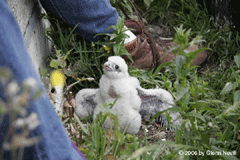
High atop 201 Mission on the 30th floor balcony, a young eyas is about to be banded by Brian Latta.
(Copyright © 2006/2007 Glenn Nevill)
MULLANE: Now that the raptor is breeding successfully on its own, Researcher Glenn Stewart says the webcam is the public’s window onto the world of this exceptional bird.
STEWART: For thirty years, we’ve been looking at these birds through binoculars and spotting scopes and now for the first time anybody in the world with an internet connection can watch the intimate family life of a peregrine falcon and just people are thrilled by it.
MULLANE: Part of the thrill, Stewart says, is that web-cam wild life is unedited.
STEWART: They see exactly what happens. They see when the eggs don’t hatch or when they hatch and the babies die and so that’s a little bit hard sometimes, but people come to me and say I didn’t know I was a bird watcher until I saw these birds.
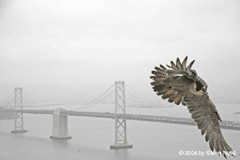
During the banding of the eyas, the mother falcon (Gracie) made multiple passes to try to drive off the biologists. (Copyright © 2006/2007 Glenn Nevill)
[SOUND OF STUDENTS ENTERING ALL-PURPOSE ROOM]
MULLANE: Stewart makes dozens of visits each year to nearby schools. He says it’s one way of guaranteeing the future protection of the species.
On a recent visit to a middle school, Stewart brought along a six-year-old falcon named Curtis.
STEWART: Actually…don’t go behind…they don’t like to feel surrounded.
[SQUAWKING]
MULLANE: Stewart moves in and puts on a thick leather glove. He holds his arm out for Curtis. The student’s eyes are wide. Curtis carefully steps onto the glove. Then in one smooth movement, Stewart slips a custom-made leather hood over Curtis’s eyes for the half-hour trip back to the Research center.
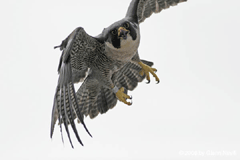
This shot of Gracie was taken with a 400 mm lens in the vain attempt at reading her band numbers. The number (1807-02648) was finally read through the window after banding of the eyas was completed. Using their database, the biologists were able to determine that she had been banded as a year old bird in the Marin Headlands on November 28, 2001 thus making her about 6 years old. (Copyright © 2006/2007 Glenn Nevill)
[DOWNTOWN CAR SOUNDS]
MULLANE: While the San Jose group watches and waits for their three fledglings to fly in San Francisco, another group of falconistas keeps tabs on a couple they know as George and Gracie. Cheryl Wolfcale says she was bit with the falcon bug after birders came into the law firm where she works.
WOLFCALE: The bird people came in, wanted to look out our windows and I thought, this would be interesting to explore, find out what’s going on and I’ve been wandering the streets at night, coming out on the weekends and (laughs) more nights than I care to admit to.
[PIER SOUNDS]
MULLANE: As she talks, her eyes scan the sides of buildings. Then, like people bar-hopping, Wolfcale and her friends, Kanit Katrell and Glenn Nevill soon leave the downtown streets and head for next stop, the end of a pier on the bay. They set up two long-range scopes and focus binoculars and cameras hoping for a sighting.
KATRELL: We do have a relationship. Cheryl and I talk to her, we talk to Gracie (laughs) and George.

This front view of Gracie shows the protrusion on the upper mandible (tomial tooth) just behind the curve of the beak, and the matching depression in the lower mandible- two features that are used to aid in severing the spinal cord after prey has been caught. (Copyright © 2006/2007 Glenn Nevill)
NEVILL: But we are also fully aware they could care less what we think.
MULLANE: As the sun starts to set the group begins to talk about packing up and going home, but it turns out that’s just talk.
SAN FRANCISCO GROUP: They’re still here and there’s always next year. Ok, there’s one flying going back to the east there it is flying, oh yes it landed right on the scaffolding.
MULLANE: This kind of love may be one-sided but it may well keep the Peregrine falcons alive and well. For Living on Earth, I’m Nancy Mullane.
SAN FRANCISCO GROUP: Now Gracie’s hoping back there. They’re back in the corner in the dark now. Love Shack we found the love shack. (laughter) They disappear at night they give us the slip. Like 7:30 8 o’clock so Cheryl says they’re off to their love shack can’t see them.
[MUSIC: The B-52’s “Love Shack” from ‘Cosmic Thing’ (Reprise Records - 1989)]
GELLERMAN: You can find a link to the falcon cam, at Loe dot o-r-g. WE don’t egg-actly know but estimated hatch date for the San Jose chicks is June 15th.
[MUSIC: The B-52’s “Love Shack” from ‘Cosmic Thing’ (Reprise Records - 1989)]
Links
San Cruz Predatory Bird Research Group (includes a live web cam)
Living on Earth wants to hear from you!
Living on Earth
62 Calef Highway, Suite 212
Lee, NH 03861
Telephone: 617-287-4121
E-mail: comments@loe.org
Newsletter [Click here]
Donate to Living on Earth!
Living on Earth is an independent media program and relies entirely on contributions from listeners and institutions supporting public service. Please donate now to preserve an independent environmental voice.
NewsletterLiving on Earth offers a weekly delivery of the show's rundown to your mailbox. Sign up for our newsletter today!
 Sailors For The Sea: Be the change you want to sea.
Sailors For The Sea: Be the change you want to sea.
 The Grantham Foundation for the Protection of the Environment: Committed to protecting and improving the health of the global environment.
The Grantham Foundation for the Protection of the Environment: Committed to protecting and improving the health of the global environment.
 Contribute to Living on Earth and receive, as our gift to you, an archival print of one of Mark Seth Lender's extraordinary wildlife photographs. Follow the link to see Mark's current collection of photographs.
Contribute to Living on Earth and receive, as our gift to you, an archival print of one of Mark Seth Lender's extraordinary wildlife photographs. Follow the link to see Mark's current collection of photographs.
 Buy a signed copy of Mark Seth Lender's book Smeagull the Seagull & support Living on Earth
Buy a signed copy of Mark Seth Lender's book Smeagull the Seagull & support Living on Earth

